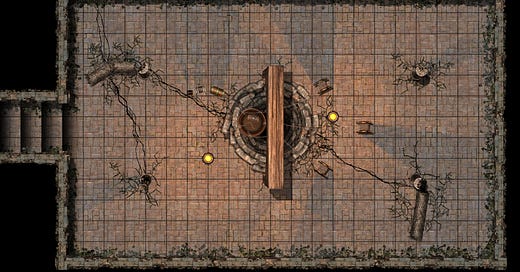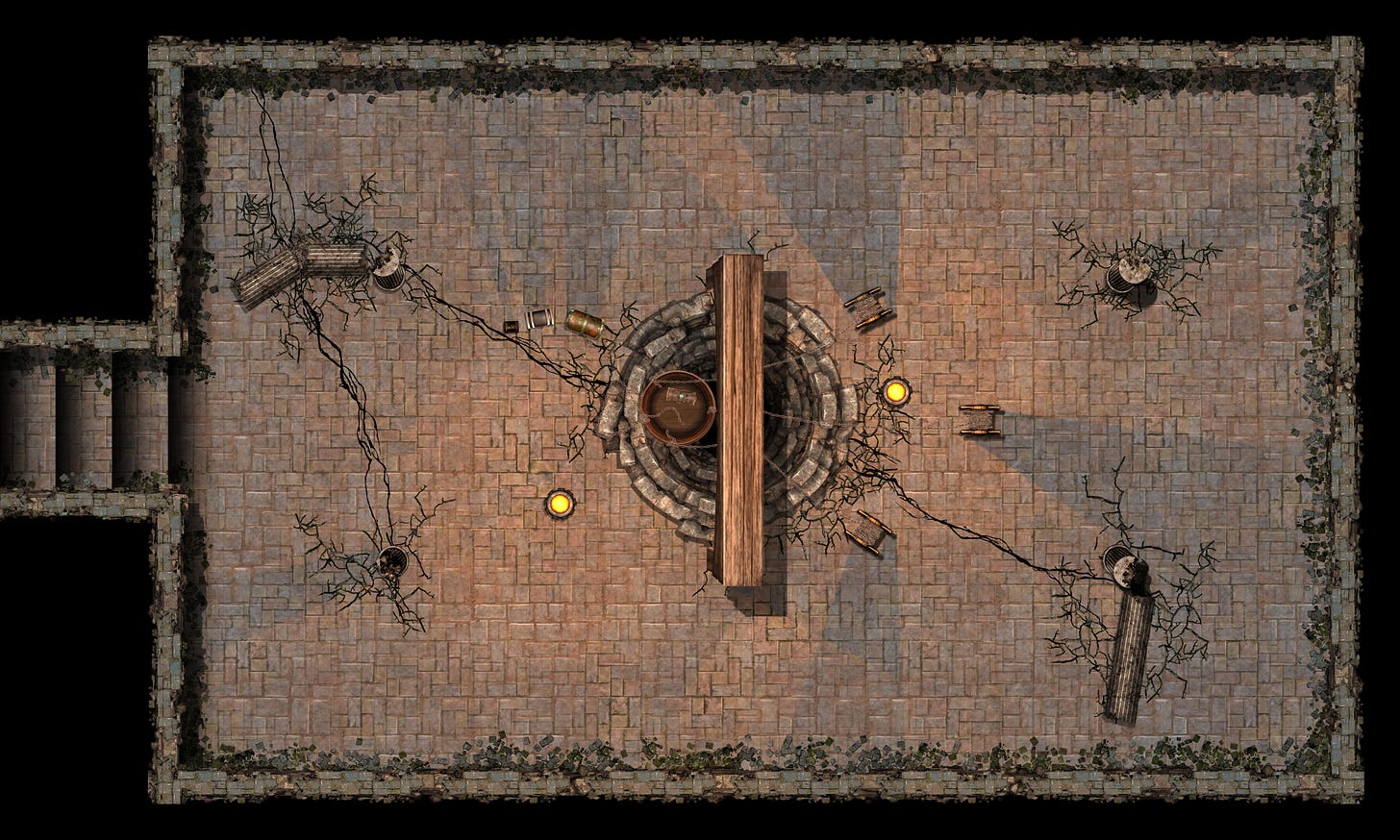Welcome to our RPG community newsletter!
Do you dream of making your mark, maybe several actually and on say…a map or a game? Then you're in luck!
Here's what we'll cover today:
Schlau continues to share about his journey into ttRPG cartography. In part 2 of his series, he elaborates on some of his methods and tools.
Oh, and he once again graciously has made maps for readers to enjoy.
I share some random thoughts about the two sides of the game coin: playtesting and designing.
Robots get real about how they feel. (Maybe??) I flesh out my decisions and creative process as we enter week 3 of the “make a game with me” series.
And now, as always, my intro gif:
I’m K.J. - hobbyist writer, creator, long-time GM , and player who loves supporting others in the RPG community. I also playtest and proofread scenarios. I enjoy playing bass guitar and eating dark chocolate but not simultaneously.
I started Watch Well Games at the end of 2023 to build a community around the hobby we have in common - RPGs. Join me as I share what I learn along the way.
My Journey into Cartography: Part 2
by Schlau (Light in Darkness Gaming)
Last time I shared my personal journey from grade school math to cartography. This edition will cover my chosen methods of creation and relevant resources. I am by no means an authority on all things cartographical, but this is my journey and I have enjoyed it.
I have used everything from scrap paper to paid software to make my maps. I have fun with all the different mediums, but there are a few I am currently really enjoying.
When it comes to making maps on the computer, there are three strategic resources I utilize above all else. I ask myself a few questions when deciding if a software is something I want to have and utilize. First and foremost is whether or not it uses AI. I will not use AI for any resources I create, especially for sale. This is just my personal choice. I respect everyone’s opinion to make up their own mind on that.
Secondly, I ask myself “Is it fun to use?” If I am going to spend hours creating a resource, I don’t want to suffer through the ordeal. I want to be close to my family as we work on our individual projects. We chat and listen to music and crack jokes. This is a highlight of any day I get to work on maps.
Next is the utility of the program. Can I export into the file types I need? Does the software have flexibility and allow me to truly create what I want? (This leads me to thinking about the next newsletter submission, where I can discuss the varying styles of cartography I have used or want to learn about). When I get an idea to flesh out before my eyes, I want my family to be proud of what I created, so will this be possible with program xyz.
My most-used resource is Arkenforge. I have invested into a large swath of their assets, and I have not been disappointed. They have a solid and supportive Discord community where I have been able to develop and hone my craft. And there is so much more available there above and beyond simple map-making. It is truly a must-have resource. Exports to a very wide variety of files with excellent importing and exporting options.
Another of my favorites is the free version of Dungeon Scrawl (DS). A little learning curve to get into the details of map manipulation, but the Discord community is there once again to assist with anything you need. There is a paid version (I can’t currently invest in), but the free version is fantastic to make homebrew maps and, my personal favorite, play around with ideas to be fleshed out later. I don’t publish from DS, but I use it regularly. Its versatility and utility are not as universal as Arkenforge, but they have earned my respect with its simplicity. Not as good with exporting varieties of files on the free version, but does allow the basics and imports.
Another must-have software for me is GIMP. I can’t imagine selling maps without using this tool. It has some downs, but the ups are worth it to me. Whenever I run into a task I can’t figure out, I can look up videos and discover just the right one to teach me what I need to know. I make all my cover pages in GIMP, too. It has a creator-friendly UI once you spend some time learning how it is laid out. The only down-side for me is the image quality when fine details matter. I will rarely make maps or assets in GIMP because it changes the image to pixels, creating a non-HD finish in my opinion. But compared to the similar tools that require purchase or subscription, GIMP has my vote. You can import and export a HUGE selection of files!
Software can help make simply beautiful and immersive maps. But I have discovered the sweet simplicity of minimalism as well. Recently I have started playing around with isometric and hand-drawn maps in black and white. It has allowed me to really grow in my artistic ability. Landscapes were always challenging for me, and what I attempted at first wouldn’t have made it onto my grandparent’s refrigerator because it was so bad. But with some practice, and a few videos and lessons from MapEffects.co have helped me do a much better job, producing maps that I am proud of.
As helpful as a beautifully colored map can be, sometimes what I want is a simple, black and white, hand-drawn map. With well-placed details, a little bit of design can stir the imagination and let the observer fill in details from their own stores of knowledge. Sometimes I start with a rough design in a map software to get the layout right, but just as often I use graph paper or sketch pads. Once I have the room arrangements, I can get started with the map propper. The end result is almost always printer friendly, and the advantage of the map not taking away from the adventure is plain. A very large portion of adventure modules use this method for similar reasons.
When it comes to making maps, a few considerations need to be made. Here are some that I consider:
What is the purpose of the map? Combat, exploration, or something else?
What view best serves the setting and story? Top-down, perspective, or Isometric?
What story, if any, does the map need to tell?
How does the map add to the adventure? What needs to be left out?
Who will be using the map? Only the GM or the whole table?
Is there a need for separate maps for the GM and the players?
I hope this article inspires the cartographer and storyteller inside of you. In the future I will write about my creative process for a single map that I make for all of you amazing newsletter subscribers*! (*Yep, while still free, some stuff will be start being for subscribers only.)
Here's this week's free maps from Schlau:
If you have trouble accessing these or missed any free maps:
Use this Dropbox link. (Note: Dropbox does not require an account or sharing your personal data. Simply select the option to go directly to the download.)
If you use any of Schlau’s maps, drop us a comment below. How did you use them and what RPG was played?
Find Schlau’s other maps on DriveThruRPG:
Random Thoughts from K.J.
Being a playtester of RPGs (and previously, video games also)- I enjoy reading about playtesting so I can continue to give quality feedback as a playtester as well as learn about the different aspects I need to consider when designing a game.
One Game Developer article I enjoyed reading this week may inspire you in your gaming endeavors.
In brief, I appreciated this article reminding me that creating stuff should be fun. We need to keep learning and asking questions. When we give feedback, we need to share what’s confusing, frustrating, difficult, uncomfortable, and exciting. We need to help creators see when things stop working for us. Telling others when or where stuff breaks helps creators fix what’s broken. Lastly, we need to remember that what works for one game may not work for another.
Whether it’s a game concept or some other IRL situation, honest communication that benefits the receiver ultimately can benefit you - once the issues are resolved. Being mindful when we give feedback - even if it’s initially negative - should aim to help those around us know how to improve what they’re working on.
Have you ever gotten (initially) negative, yet incredibly helpful feedback on a game, artwork, or other project that ultimately benefitted you? Leave a comment below - I’d like to know!
A brief interruption
The Watch Well Games Creators Spotlight Bundle
16 creators. 13 Pocket Quest games. One bundle. Easy gaming for quick pick-up sessions.
Pocket Quest 2024 was DriveThruRPG’s third annual game jam that encouraged game creators new and veteran alike to make a fully-contained game in 25 pages or less within a (slightly less than) two-month window.
No doubt, you’ll find something here you and your friends/fam can enjoy!
“Make a game with me” - Week 3
Going deeper into the details as I make a game in front of you the audience.
If you missed the last two newsletters, they’re free and can be accessed here:
Status Update for Week 3:
Character sheets will have at least the character name, description (with optional picture), skills, and abilities. There will be more as I flesh things out, but these are the basics. I don’t intend for this to be an overly crunchy game. Think of Pirate Borg or CY_Borg.
Character creation will be a mix - I think. Some readers suggested rolling for stats like strength and speed. I will combine this along with another suggestion: players roll for half of their skills, abilities, etc. and then spend so many points on other attributes that need numbers.
Characters start at The Main Frame. Oh yeah, I’m gonna build this idea out. I may even do some artwork for this bad boy.
I think a well-built roll table will be used for obstacles and challenges. More on this in week 4. At this point, I plan to include locked server rooms, POIs that need hacked, dangerous defense programs, and even more dangerous company employees.
I’ll stylize the game so that characters must overcome obstacles and challenges preferably without violence, weapons, and fighting. I may even create a penalty system if any of these are used. Remember: I want this game to be utterly ridiculous fun. PCs will need to use their skills, traits, etc. to gain work up Maslow’s pyramid of needs as they become more human.
I really like opposed rolls, so I may very well go with this mechanic. I need to test early and often (as the saying goes) to see if it works. I’ll still use the Start With Six game engine I’ve been developing for almost the past year.
Characters can “die” or stop functioning at least (this will use one reader’s idea about the PCs’ software getting corrupted once it’s damaged). Maybe I’ll find a way for them to be scrapped or repurposed, allowing them to come back into the game. (Oh, I can totally see how this could be great fun if the game is competitive!)
I will probably lean more towards making this game co-op rather than a competitive one. However, if playtesting proves otherwise, I may change this or allow both modes.
Decide on for Week 3:
Questions we need to answer at this time:
How should we define “The Main Frame”? (This will be where PCs start playing the game, so let’s enjoy building out the origin story, if you will.)
What should we name the game?
Are there other game components that we should name? If so, what are your ideas?
If you’re just now catching up and have some ideas, feel free to join in. We’re only in week 3 of the series, ideas on any of the previously discussed decision points are still appreciated.
There’s plenty more to build out, so if there’s an aspect of the game you think should be worked on **at this point in development**, leave a comment below. I’ve only published three small games so far in a year’s time, so I’m open to learning.
That’s it for this week! Remember:
Support human creators and writers. Buy their games, play their games, leave a kind review, then let others know about the games. As always, thanks for joining me! Newsletters are always free, so spread the good word.

















